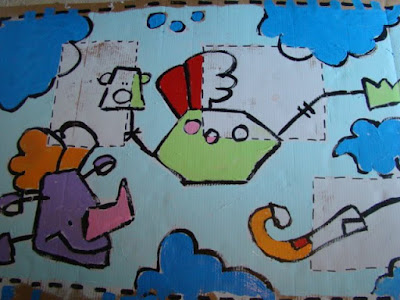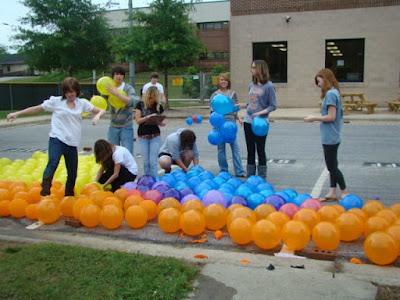Top Ten Things I Learned This School Year10. PLN’s Rock! This year I fully emerged myself in the online PLN thing. I joined
Art Ed 2.0 and the
NAEA. I signed up for
Twitter and participated in #edchat.
Previously, I was limited to seeing what other art teachers had posted to there websites. Participating in these PLN’s opened a two-way door. It was great to discover that I wasn’t the only one who felt the same way about the next 9 items.
 9. Don’t Teach The Tool.
9. Don’t Teach The Tool.One of the biggest mistakes I made when I first started teaching my Computer Art class was teaching Flash. I taught my students how to tween and even how to write actionscript. Now don’t get me wrong, there is nothing wrong with teaching a tool. However, this should be a means not an end.
I would never teach a painting lesson on the correct way to hold a paintbrush. In fact, I probably shouldn’t even teach a lesson on how to paint. I might however, teach a lesson on complimentary colors. In order to teach that lesson, I might decide to have the students create a work of art using paint. Then, while teaching this lesson I might discover that my students don’t know how to correctly hold a paintbrush.
8. Don’t Get Bogged Down by Standards. While I’ve learned that I should teach the concept and not the tool, I’ve also discovered that the creativity in my teaching can be held prisoner by standards. i.e. If the standard says I am to teach the elements of art, that doesn’t mean I have to stand in front of the class with a chart that lists the elements of art. In fact, I could make a good case that the common current list of art elements is at best incomplete and in some cases obsolete. The standards should be a guideline, not a stop sign.
 7. What’s a Watch?
7. What’s a Watch?Students don’t own watches, they don’t own cassettes, and they don’t know what a floppy disk is. They’ve probably have never seen or used a typewriter. However, they can name more fonts than most teachers can.
As a teacher, I need to stay current as well. I need to change and adapt my lessons to align with today’s reality. I have to ask myself, is what I’m teaching relevant to what my students need to learn?
i.e. When I teach color, should all my focus be on mixing primary colors? Outside of art class, my students never mix primary colors. Instead, they mix RGB and CMYK… and on a daily basis.
6. New MediaI don’t like Christmas songs. I might not mind them so much if there were some new ones however, it seems I hear the same old tired Christmas songs every year. People often disagree with me, labeling it tradition. I don’t have anything against tradition unless tradition becomes a roadblock.
Art teaching can become very traditional. I teach contour line drawing in pencil in 2010 because my art teacher taught contour line drawing in pencil in 1985. She probably taught contour line drawing in pencil because her art teacher taught her it back in 1965.
The question becomes, do I teach contour line drawing in pencil because it is the way to teach or because it is tradition? Is there any other media I could use to teach the same lesson? What about masking tape, or an etch-a-sketch, or a dirty car window? These might seem silly until you Google those topics and see the incredible art being created using those media.
 5. Vocabulary Can Suck
5. Vocabulary Can SuckThe Purpose of Vocabulary is to help us understand and communicate our world. Not the other way around. The teacher temptation is to provide a list of vocabulary and expect our students to memorize an exact dictionary sentence that defines the word. The student temptation is to rote memorize the definition to please the teacher and receive an A on the quiz.
What I’ve learned is to let go of the dictionary. I provide the words but let the students write their own definitions so they in turn can use their words to understand and communicate their world.
4. Teaching Dead White GuysI started a forum on Art Ed 2.0. titled The Top Ten Artist Every Art One Student Should Know. The discussion became divided into 3 sections:
1. Old dead white guys
2. Hip new people that you’ve probably never heard of
3. Women and minorities
What I’ve learned from this discussion is that we need to stop categorizing artist by age, gender, race or anything other than their artwork.
 3. Visual Connections and Renoir’s Red Hats
3. Visual Connections and Renoir’s Red HatsKandinsky was born in 1866. I have always thought Kandinsky’s art looks like candy. In fact, that is how I teach it. Kandinsky looks like kandy. I sometimes have a hard time telling Miro and Kandinsky apart. I think their works tends to look similar. It could just be me.
At the end of the year, I ask my Art History students what they feel worked best in the class to help them learn. This year the answer I received back the most was more stories and more visual connections.
i.e. when learning about the impressionists, I point out that you can usually tell a Renoir because he painted a lot of people in red hats. If I show an impressionist painting and there is a red hat, it’s probably Renoir.
If you don’t believe me, try a Google image search for Renoir. You will see all of Renoir’s red hats. If you don’t believe my students are right about visual connections, then answer these two questions without looking back at what I wrote.
1. When was Kandinsky born?
2. How can you recognize a Kandinsky?
Were you able to remember the answer to number two but not number one? That’s the power of visual connections.
2. Web 2.0. is Not a Part-Time Gig My wife is a Realtor. She has many conversations with people who are thinking about going into selling real estate to supplement their income. That’s not possible. Being a Realtor is not a part-time job.
Teaching is not a part-time job, even if you are a part-time teacher. I’m sure that comes as no surprise to anyone reading this post. Likewise, Web 2.0. is not a part-time gig.
To use Web 2.0. tools means you need to live Web 2.0. tools. If you use Twitter, you use it everyday and in more than one way. You can’t come to school Monday morning, explore Twitter during your planning period, and then expect to teach a class on Twitter to your second period. Web 2.0 is fulltime.
1. There is No Number OneI started by saying PLN’s rock. If I filled in number one it would defeat the purpose.
ian sands
Zonkey Street



































